The weather had suddenly turned warm and out of the woodwork crawled the following 12 candidates for the Ascension Day picnic hike starting at Arzier at 10 ish.
Meeting at Divonne 9.30am
Richard S
Mark2rs
Philip
Mervyn
Nathan
Ralph
Mark2ts
Meeting at Arzier at 10am- ish
PeterT (plus Kobie)
Ross (travelling with PT)
RobP
Rudi
Larry
There were apologies from Thatcher, PeterS, MikeM, and others had standing excuses (MikeH in the Med, Stephen in recovery mode, Bill away) etc.
We welcomed Ross on his first hike. Ross lives in Coppet and hails from downunder (Aus). His interests include inter alia : mountaineering/climbing, hiking, motorbikes, guitar and playing the didgeridoo.
In the event only Ralph had braved the start with shorts, some other gintlemen having adaptable kit reverted to shorts later on.

We started up (heck it was Ascension Day) into the forest, steeply at first in the bright sunshine, but gradually the slope eased off and the usual early grumblings subsided.
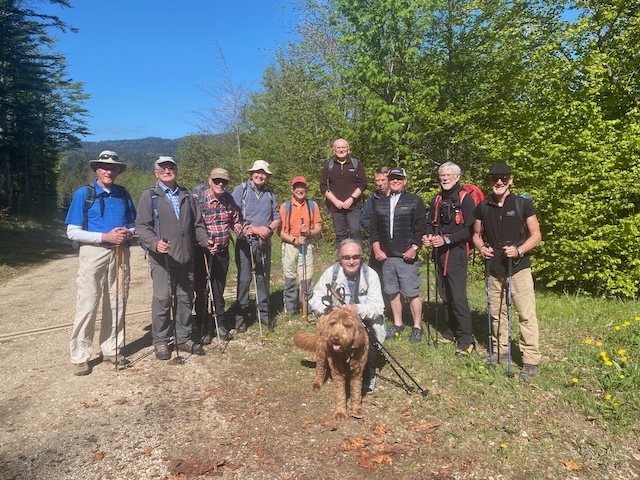

The weather was indeed warming up and the sun shone through the trees as we reach the Charteuse d’Oujon – the ancient monastery in a clearing in the forest. We said our prayers and passed through the grassy walled sacred place in wonderment, but found we needed to scale the wall to exit.

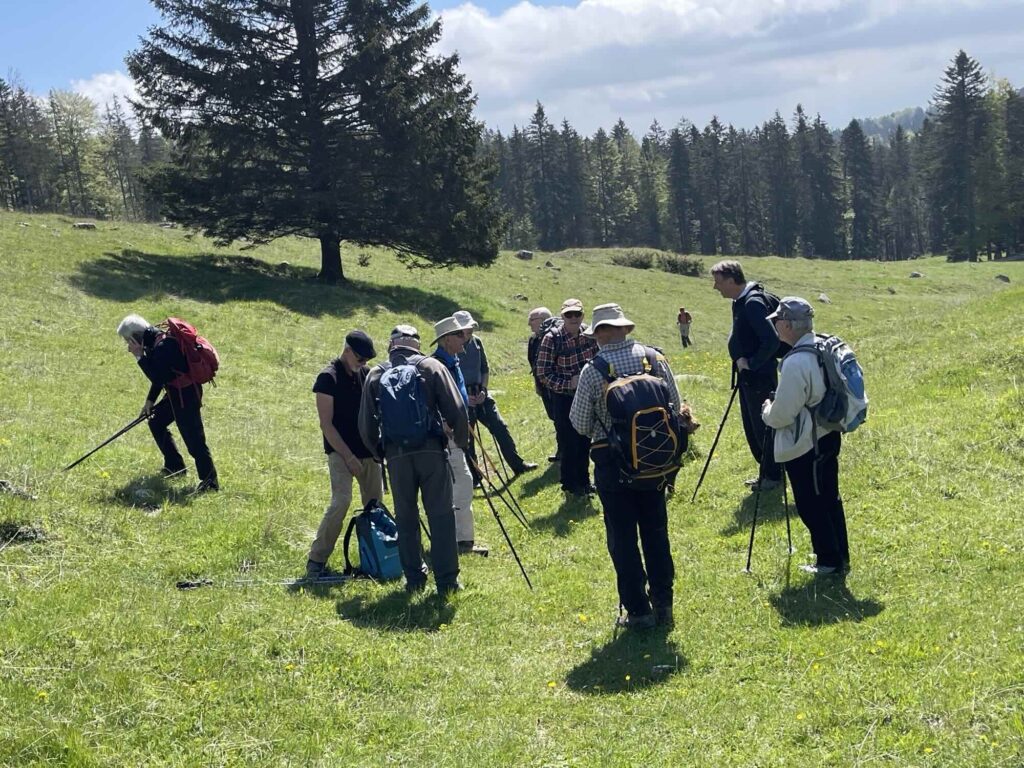
Once back into the forest we continued up and into a field which we found contained a large herd of sedentary cows. It was not long before the situation changed and the back of our train were being stampeded down the track.

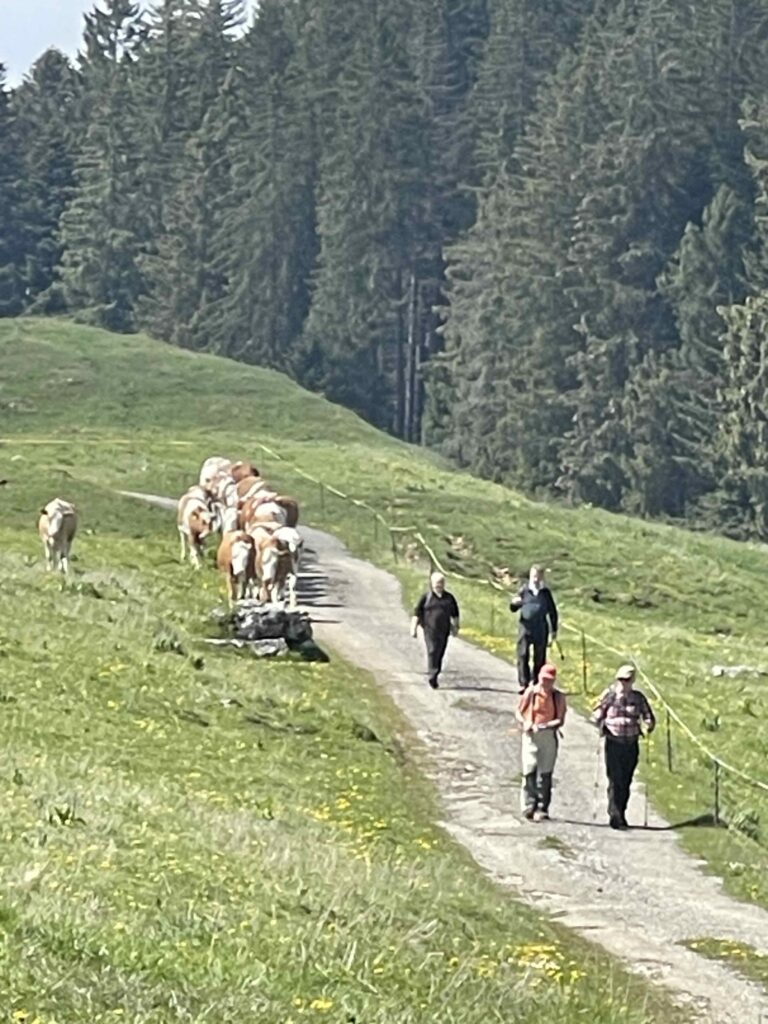
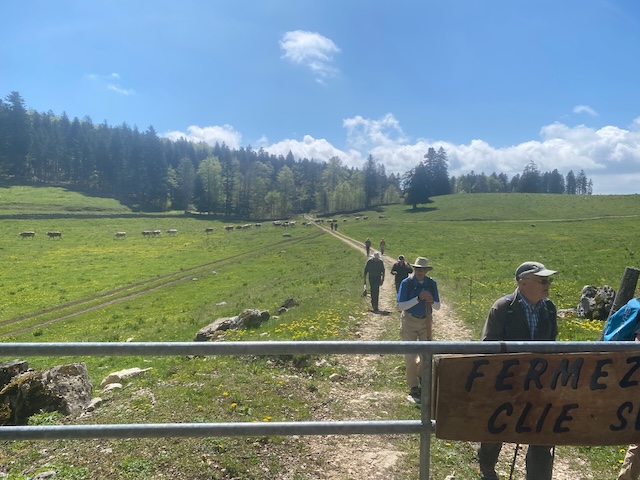
We escaped them and another herd without incident and headed on up towards the Fruitère de Nyon. The perceptive may have picked up that the Leader was (not lost but) wavering between various route options, although after a while it became obvious that we were going to be headed for Givrine rather than La Cure (as in 2021).
As time was passing (we were past the 1 pm lunch hard stop), a direct ascent was chosen to reach the Leader’s chosen lunch spot just down from Cabane Rochefort, the steep trajectory was much appreciated by Larry who was happy to be testing his heart.


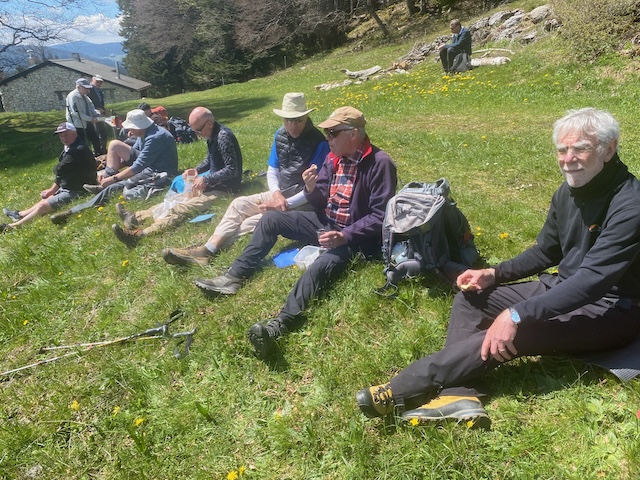
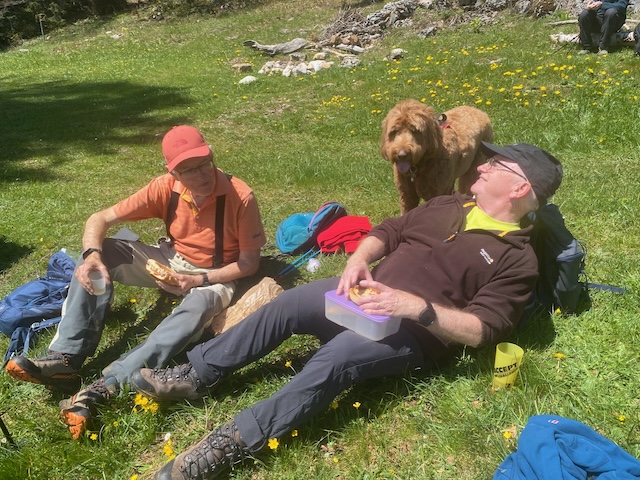

We were blessed with an excellent array of waiters offering biscuits, crisps, vegetable dips, nuts, wines, coffees, and stonger liquids. Richard’s bottle contained Disaronno (for the record). It was remarked that here was a liquid that started with “dis” and ended with “no”; it tasted excellent. Sadly the view in front of us extended only to Lac Leman, as the Alps were behind white fluffy stuff. Some became sleepy in the warm sun.
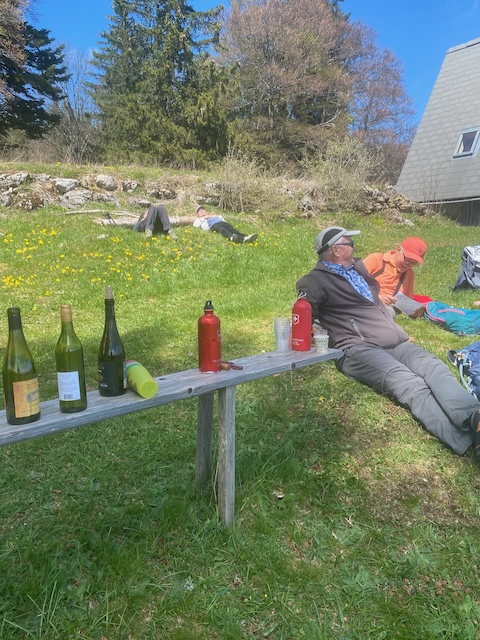
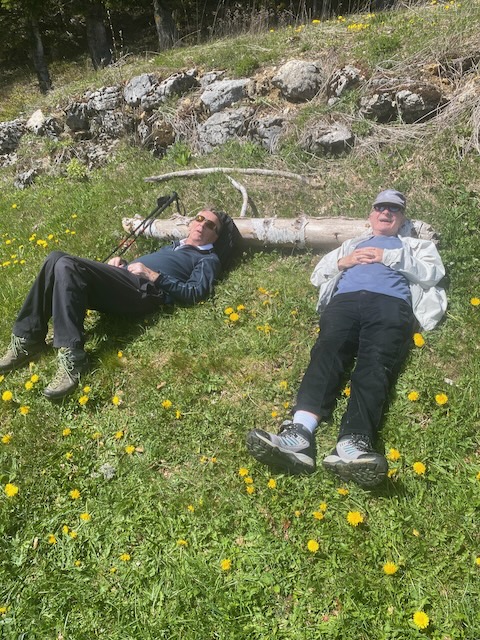
At some point in the proceedings we drank a toast to absent friends. Discussions ranged between topics of world concern including independence efforts, to the price of carrots. All of a sudden another Cobberdog from the same breeder (DogKing in Barcelona) appeared, Poppy a miniature 2 year old. Kobie showed little interest as he was making steady progress in finding a way into Larry’s pack to access a remaindered salami sandwich.
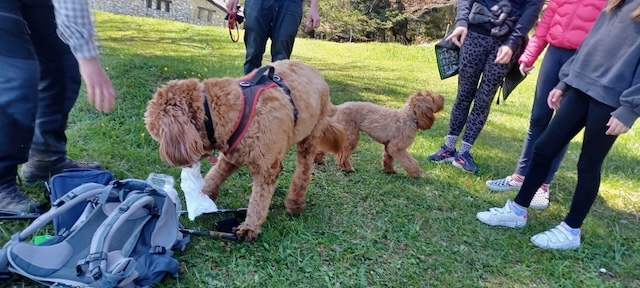
It was at around 2.20 pm that the Leader realised that we would need to get packed up smartish and out on the trial to catch the 3.48pm train at La Givrine. A short hike up past Cabane Rochefort led to the pleasant forest trail back through a gap in the wall and past La Genolière at some distance. We were a little strung out, but needed to press on to make our train rdv. It was a pleasant walk up through grassy fields and then down the tarmac track to La Givrine (it was not possible to use the forest trails as the summer barbed wire fences were out in force). It was touch and go for the back markers, but we all made it in time and were soon ensconced in the train which took us to Arzier where we waved goodbye to Rob and Rudi who stayed on to descend further.
The sting in the tail was a 75m hike up from the train station to the cars. Altogether 14km and 700m, a little shorter than April 21 where we reached La Givrine, but we had a similar height gain.
PS That evening Kobie went to his basement bed as soon as he had had his foot wash at 5 pm. He reappeared the next morning. No supper needed. Larry’s sandwich (and happily not the plastic lid of his tin of nuts) had topped up all the other treats that he had cajoled from pickniking gintlemen. Thanks to all for the fun, and for putting up with my hound. PT
————————————————————
Appendix 1 Chartreuse D’Oujon
Chartreuse is first of all the name of a mountain massif, which gave its name to a religious order which was founded there in the 11th century. This order founded monasteries (called Carthusian monasteries) around the world. Many are no longer in operation but the name has remained on the buildings or places. The nuns of this order are also called Chartreuse, a liqueur produced by monks, and other works directly or indirectly related to the history of the religious order.
The Chartreuse Notre-Dame d'Oujon, founded in 1146, located in a clearing in the Jura in the territory of the commune of Arzier-Le Muids in Switzerland, is the oldest chartreuse in this country1. It was abolished in 1537 during the Reformation. Archaeological excavations undertaken in 1945 brought to light the remains of its buildings2.
The Carthusian Order, resulting from the second reform of Benedictine monasticism, was founded in 1084 in the mountainous massif of Chartreuse, above Grenoble in Dauphiné, by Saint Bruno, schoolmaster from Reims and German from Cologne. The founder seeks purity and devotion to God by isolating the monk from the influences of the outside world. Which explains the choice of isolated places to shelter the Carthusian communities. The very architecture of the monastery reflects the ideal of eremitic life of the community which generally has no more than a dozen monks. Each of them spends most of their time in their cell (small house with garden) and the common areas are designed on the model of those of the Benedictines.
The order spreads from the Chartreuse massif towards the north. The slopes of the Jura, then quite inhospitable, are sparsely populated and isolation is one of the qualities sought by the community. However, the site chosen around 1146 is not too far from a fairly important communication route leading to Saint-Cergue. The name Oujon undoubtedly comes from the topography of the place, the Latin word augio meaning “trough”. We do not know the precise date of the consecration of the Notre-Dame church. During its installation and over the centuries, the charterhouse received numerous donations, in particular from Olivier de Mont (Lord of Mont-le-Grand whose ruins of the castle are still visible on the territory of the current commune of Mont-sur-Rolle). The Chartreuse became an important lordship and sometimes came into territorial conflict with its neighbors, such as the lords of Mont and Genolier as well as the abbeys of Bonmont and Saint-Claude.
In 1306, the monastery founded the parish of Arzier.
A fire struck the Chartreuse in 1536, while the Reformation was raging in the country of Vaud under Bernese domination. The Carthusians, in 1537, then asked the Bernese representatives for authorization to rebuild, but this was refused. The last three monks were expelled8, which marked the end of the existence of the Carthusian monastery of Oujon, after four centuries of existence2. The ruins were gradually pillaged by the inhabitants of the region, so that only the foundations and a few walls were unearthed by the first archaeologists in 1945. The following excavations were undertaken in the 1970s. The site is now highlighted and can be visited; it is classified as a Swiss cultural property of national importance9. The furniture discovered during the excavations is preserved by the Nyon historical museum3.
Appendix 2 The Flyer was :-
“The weather is improving and 9 May is Ascension Day, which augurs well for those wishing to ascend.
I am therefore thinking of another start from Arzier, “up and over” and returning by train.
See below – this might be 700m ascent (see below) and 13km, but I remember it being quite gentle. I’ll vary the route from last time, a little, and we could finish at La Givrine if desired (there is a bar there).
The start will be at the parking at What3Words losing.hiding.outsiders or unhappily.rots.vines , in the bend of the road after Arzier just as it turns sharp left towards St Cergue.
At 10 am -ish on Thursday 9 May 24.
Those wishing to meet at Divonne at car pool should do so at 9.30am.
While we could lunch inside somewhere, as the weather forecast seems so good and the other Ascension day hikers will be out and eating at the huts, I propose a picnic. So please bring a picnic etc.
We last did this walk on 15 April 2021 when there was still snow about up there. This time no masks needed, and I now know the train timetable like the back of my hand …
Please advise me by Weds evening if you are coming.
Likely I’ll be taking Kobie, on a leash.
Best foot forward
Peter”
